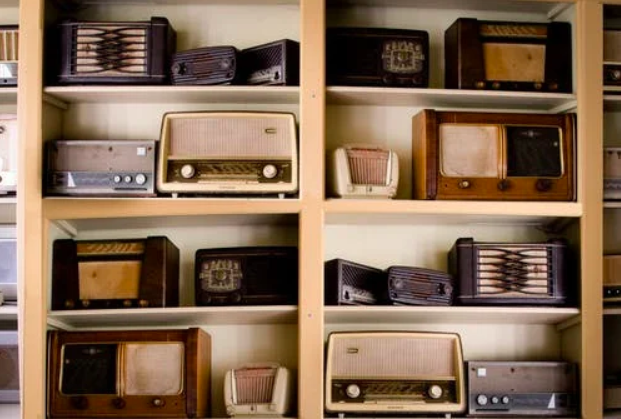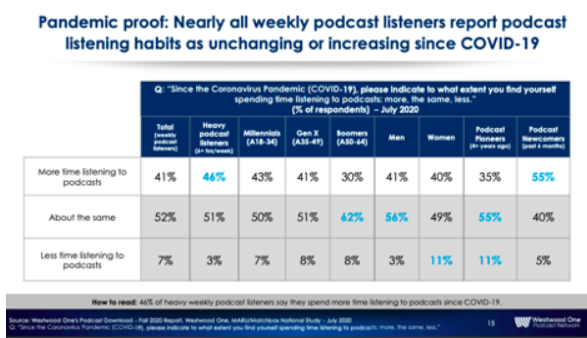Tuning In: an Audio Resurgence
written by Miranda Allegar - December 23, 2020
Amidst the pandemic, a trend clearly emerges. Audio storytelling is back in a big way. As audience members seek entertainment amidst new rounds of stay-at-home orders and a long winter ahead, theaters turn increasingly to the audio drama format, a savvy move amidst rising podcast and audio listenership. One survey, conducted in July of 2020 by Westwood One’s Podcast Download report, shows that 41% of podcast listeners report spending more time listening to audio content while just 7% are listening less. 55% of newcomers to the audio sphere, defined as those who have been listening for six months or less, also report increased listening rates as a result of the pandemic, while 40% report listening “about the same,” indicative that some substantial portion of these newcomers have begun listening during and as a result of the pandemic.
However, this recent bump in audio listenership is far from new. Audio and radio storytelling has a long and storied history in the United States, first coming to prominence in the 1930’s amidst the Great Depression and the interwar years. The media remained at the forefront until the advent of television, which gradually replaced the radio for both entertainment and news content. However, the 21st century has seen a slight reversion to audio formats, especially with the rise of podcasting technology. As seen in the data from this fall, this trend seems likely to continue through this pandemic, calling to mind the need for escapism amidst the American public, both in the ‘30s and ‘40s and now.
Increasingly, theaters begin now to turn to the format, capitalizing on this trend amidst the many restrictions that surround public gatherings in 2020. One such instance is the recent adaptation of It Can’t Happen Here by the Berkeley Rep for the audio format. The story itself, adapted from Sinclair Lewis’s 1935 dystopian political fiction describes the rise of fascism in the United States as a man named Buzz Windrip gains the presidency. While Lewis’s plot provides the modern listener plenty to think about in an election year, with overwhelmingly transparent parallels to be drawn between Windrip and Donald Trump, the piece also highlights the connection between the Golden Age of Radio at the novel’s writing and the present moment, inviting questions of comparison and contrast between the time periods. Further still, this version replaces an earlier stage adaptation of the novel, placing some further distance between the theater of the pre-pandemic years and the theater landscape of today.
Nor does this piece exist in a vacuum, as more and more theaters announce audio adaptations in their upcoming seasons. Another Berkeley theater, the Aurora Theatre Company, uses the moment to produce an original work of audio drama entitled The Flats, with plans announced for a second audio drama in the spring. Further north, at least six Seattle-area theaters move to the airwaves, including the Sound Theater Company, Book-It Repertory Theatre, Seattle Shakespeare, the 5th Avenue Theatre, ACT, and Seattle Public Theater. Book-It Repertory Theater will, in fact, offer an all-audio season.
This transition to audio drama has been reinforced by audiobook company Audible’s foray into theater through its Audible Theater initiative, formed in 2018, which includes an Emerging Playwrights Fund for new works. The platform has only continued to grow throughout the pandemic, even taking on the entirety of the Williamstown Theatre Festival’s season for 2020. In an interview for Variety’s “Stagecraft” podcast, Audible Theater’s artistic producer Katie Navin described the program: “‘Audible Theater really started out of a desire to make theater available to more people,’ Navin said. ‘How can we employ under-employed theater artists? … What can we do to provide more opportunity in that space?’” Such a mission seems all the more apt amidst the pandemic.
Innovations in Socially Distant Performance expects the audio drama to remain a fixture of the pandemic theater world. The form supports listener desires for entertainment and storytelling without adding to the ever-growing burden of eye strain and excessive screen time. Further still, the form allows theater-makers to continue to produce and distribute work while spaces remain closed and in-person performances delayed. The medium is a safe, easily distanced means of evocative theater, providing respite from the threat of the virus for both creators and audiences alike. This safety is only compounded by the emergence and popularization of audio capture technology that allows actors to record from their own private spaces, hearing the feeds of their fellow performers, but with distinct and distanced feeds from each performer to be interwoven through editing and sound design. Ultimately, this pivot toward audio drama proves further evidence in the continuing elision of various performance forms around the core nexus of storytelling. Podcasting and theater and radio blurring together provides just one more example of the un-silo-ing of creative work amidst the pandemic.
For more on the neurological stimulation provided by audio drama, see our article by Reed Leventis, entitled “Neuroscience sheds light on audio theatre’s ability for audience engagement.”
For more on audio entertainment, read our interview with Iyvon Edebiri, the Artistic Director of The Parsnip Ship, a podcast play company.


